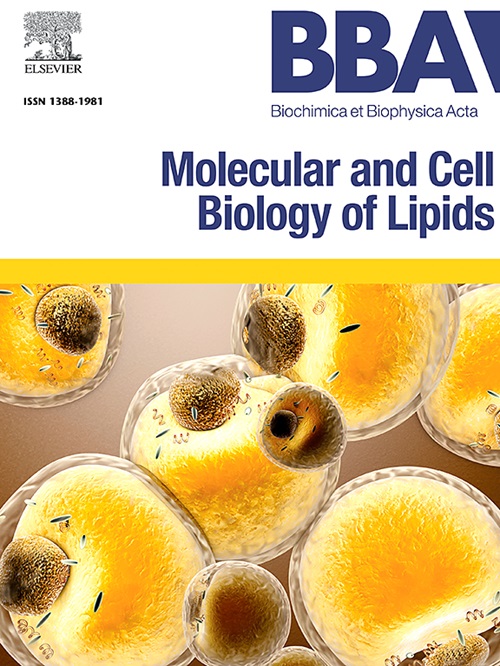Lauric acid ameliorates excessive linoleic acid induced macrophage inflammatory response and oxidative stress in large yellow croaker (Larimichthys crocea)
IF 3.9
2区 生物学
Q2 BIOCHEMISTRY & MOLECULAR BIOLOGY
Biochimica et biophysica acta. Molecular and cell biology of lipids
Pub Date : 2025-05-16
DOI:10.1016/j.bbalip.2025.159635
引用次数: 0
Abstract
Macrophages are particularly prone to inflammation and oxidative stress upon exogenous stimulus. Previous investigations have shown that lauric acid (LRA) exerts anti-inflammatory and antioxidant effects, however, the molecular mechanism remains elusive. This study aims to elucidate the function and molecular mechanisms by which LRA provided a defense against inflammation and oxidative stress brought by linoleic acid (LA), both in vivo and in vitro. Feeding trial results indicated that dietary LA led to severe inflammation and impaired antioxidant capacity in head kidney of large yellow croaker. The gene and protein expressions of inflammation-related were upregulated and those of antioxidant defense were down-regulated in the LA diet group, which were reversed by glycerol monolaurate (LRA derivative). Meanwhile, in macrophages, LRA suppressed the expressions of p-ERK and p-JNK and the gene expressions of pro-inflammatory factors induced by excessive LA. G protein coupled receptor 84 (GPR84, endogenous receptor of LRA) disturbance did not alter LRA-induced ERK and JNK MAPK pathways and pro-inflammatory gene expressions decline. Besides, LRA decreased reactive oxygen species (ROS) level and increased the expressions of nuclear factor erythroid 2-related factor 2 (NRF2). And blockage of NRF2 reversed the protective effect of LRA-mediated the protection against oxidative stress. Collectively, these results demonstrated that LRA attenuated LA-induced inflammation by suppressing ERK and JNK MAPK pathways and oxidative stress by activating NRF2 signaling in macrophages. These findings revealed that the function and molecular mechanisms of LRA alleviating inflammation and oxidative stress in macrophages, which provides new insights for enhancing immune cell function in vertebrates.

月桂酸改善过量亚油酸诱导的大黄鱼巨噬细胞炎症反应和氧化应激。
巨噬细胞在外源刺激下特别容易发生炎症和氧化应激。已有研究表明月桂酸具有抗炎、抗氧化作用,但其分子机制尚不明确。本研究旨在阐明LRA在体内和体外对亚油酸(LA)引起的炎症和氧化应激的防御作用及其分子机制。饲养试验结果表明,饲粮中添加LA可导致大黄鱼头肾严重炎症和抗氧化能力受损。LA饮食组炎症相关基因和蛋白表达上调,抗氧化防御基因和蛋白表达下调,而单月桂酸甘油(LRA衍生物)逆转了这一趋势。同时,在巨噬细胞中,LRA抑制了过量LA诱导的p-ERK和p-JNK的表达以及促炎因子的基因表达。G蛋白偶联受体84 (GPR84,内源性LRA受体)的干扰不改变LRA诱导的ERK和JNK MAPK通路,促炎基因表达下降。此外,LRA还能降低活性氧(ROS)水平,提高核因子红细胞2相关因子2 (NRF2)的表达。NRF2的阻断逆转了lra介导的抗氧化应激的保护作用。综上所述,这些结果表明LRA通过抑制ERK和JNK MAPK通路以及激活巨噬细胞中的NRF2信号通路来减轻la诱导的炎症。这些发现揭示了LRA缓解巨噬细胞炎症和氧化应激的功能和分子机制,为增强脊椎动物免疫细胞功能提供了新的见解。
本文章由计算机程序翻译,如有差异,请以英文原文为准。
求助全文
约1分钟内获得全文
求助全文
来源期刊
CiteScore
11.00
自引率
2.10%
发文量
109
审稿时长
53 days
期刊介绍:
BBA Molecular and Cell Biology of Lipids publishes papers on original research dealing with novel aspects of molecular genetics related to the lipidome, the biosynthesis of lipids, the role of lipids in cells and whole organisms, the regulation of lipid metabolism and function, and lipidomics in all organisms. Manuscripts should significantly advance the understanding of the molecular mechanisms underlying biological processes in which lipids are involved. Papers detailing novel methodology must report significant biochemical, molecular, or functional insight in the area of lipids.

 求助内容:
求助内容: 应助结果提醒方式:
应助结果提醒方式:


